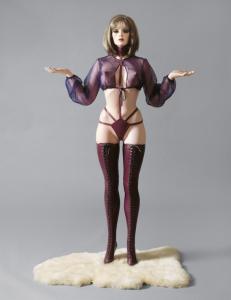
A brilliant painter derailed by an unfortunate obsession.
There’s no escaping it; Hat Stand, 1969, is a beastly object. The blank-faced mannequin is too literal to succeed as a sculpture, and the conceit is too nasty to be ignored. Her position – holding up her hands to receive our hats – recalls the torture meted out to prisoners of war by their Japanese guards in WWII. She wears fetish gear comprising a purple bolero over conical tits with teat-like nipples that point heavenwards, a restraining collar linked to a leather g-string and tightly-laced, thigh-high boots. Her body is visible yet constrained and her head is similarly encased in a helmet-like wig. The realism is important; this is a woman serving as a hat stand, not furniture whimsically shaped like a woman.
Over the years her more famous sisters, Chair and Table, have attracted considerable hostility. “Chair” lies on her back, legs in the air; the seat is strapped to her thighs so that her calves act as the chair back. “Table” kneels on all fours with a sheet of glass bolted to her back. Both are dressed in fetish gear and are in positions implying sexual availability. They are still as irritatingly silly and sexist as they were nearly 50 years ago.
But Allen Jones’s retrospective contains another Table, which is far more interesting because it is more ambiguous. Rather than flesh pink, the fibreglass is painted a dark, sparkly green, the glass is shaped like an artist’s palette and the woman’s head is lifted. Her unreal colour and more active demeanour are reminiscent of sci-fi and video game heroines; she may be enslaved but she is not cowed. And her implied role – as an artist’s muse and support – is shown to be a trap.
